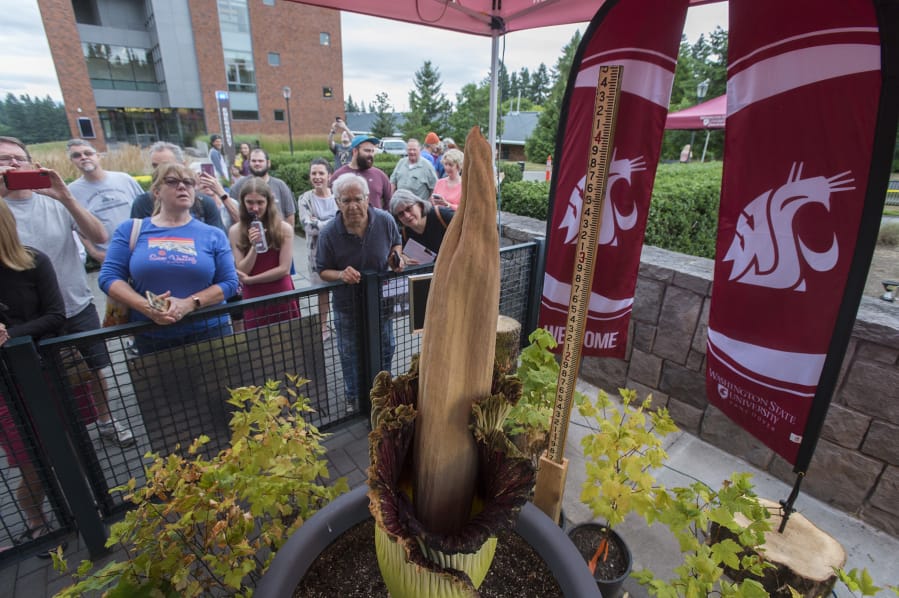For about 48 hours, thousands of visitors came to get a glimpse, and a whiff, of Titan VanCoug, the rare corpse flower at Washington State University Vancouver.
An enthusiastic Steven R. Sylvester, who raised the plant from seed, held court on campus, sharing details of the flower, whose trademark quality is an odor of dirty socks and rotten fish. On Wednesday, the flower began to collapse as it reached the end of its short lifespan.
For 17 years, Sylvester, an associate professor of molecular biosciences, has been tenderly caring for this unusual plant. But he’s doing more than that. He’s helping ensure the continuation of an endangered species.
In its natural habitat of Indonesia’s rainforests, Amorphophallus titanum is under threat. The Sumatran rainforest, marked by rich biodiversity, has been aggressively deforested in recent years for palm oil production and illegal logging. According to the World Wildlife Fund, about 12 million hectares of forest have been cleared in the past 22 years. That’s a loss of nearly 50 percent, according to the organization.
The International Union for Conservation of Nature lists the plant as an endangered species. Threatened species also include the Sumatran rhinoceros, orangutan and tiger, all of which are listed as critically endangered.
“As the forests go, so do their habitat,” said Jason Lopez, a greenhouse manager for the biology department at the University of Washington. UW has several corpse flowers in its collection.
While WSU Vancouver was celebrating the late bloom of its own corpse flower, the Missouri Botanical Garden experienced the disappointment of a fake-out. Octavia, a corpse flower whose spike stretched 8 feet tall, was expected to bloom last week but sputtered out before its leaves opened.
Emily Colletti, a horticulturist at the St. Louis center, said it seems Octavia used too much energy growing to bloom. Still, she said, there are about a dozen more corpse flowers at the gardens in various stages of growth, and when they bloom, the visitors will come.
“It’s actually awesome to see that a plant could get so much attention,” Colletti said. “It’s a great way to get people interested in looking at how important plants are to our lives.”
People are drawn to the prehistoric looking plant, Colletti said. And their presence means an opportunity to talk about the threat these and other unusual plants face.
“Our biggest thing is to educate people,” she said. “We are very aware and very conscientious of what’s happening in the plant world.”
Sylvester this week swiped yellow pollen he received from the New York Botanical Garden onto the small flowers lining the corpse flower’s spadix, or spike. If all goes well, he said Wednesday, Titan VanCoug could produce as many as 100 fruits within the next four to six months; that’s 100 opportunities for stinky grandbaby plants.
And the way Sylvester tells it, there’ll be no shortage of interest from botanical gardens, universities and nonprofit organizations. He’s already been fielding requests from researchers who’ve been asking for seeds for years.




